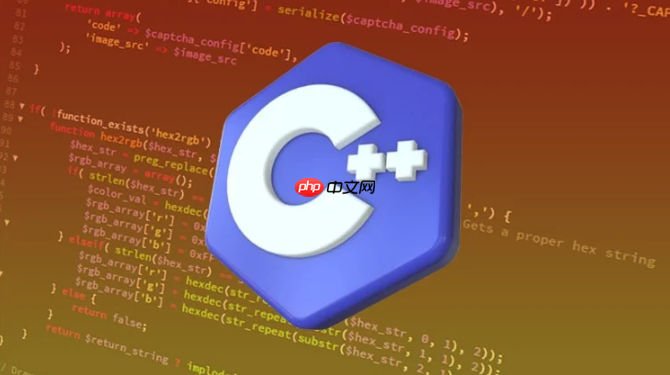C++中常用std::stoi、std::strtol和std::stringstream将十六进制字符串转为整型。std::stoi最简洁,支持自动识别"0x"前缀或指定基数16;std::strtol更灵活且可检测非法字符,适合长整型转换;std::stringstream则便于流式操作集成。选择方法时需权衡错误处理、性能与代码风格,同时应确保输入合法以避免异常或错误结果。

在C++中,将十六进制字符串转换为整型数值有多种方法,常用且简单的方式包括使用 std::stoi、std::strtol 或 std::stringstream。下面介绍几种实用的实现方式。
std::stoi 支持自动识别十六进制格式,只要字符串以 "0x" 或 "0X" 开头,或者指定基数为 16。
示例代码:
#include <string>
#include <iostream>
<p>int main() {
std::string hex_str = "FF"; // 或者 "0xFF"
int value = std::stoi(hex_str, nullptr, 16);
std::cout << "转换结果: " << value << std::endl; // 输出 255
return 0;
}
std::strtol 可以处理更长的十六进制数(如 long 类型),并提供错误检查功能。
立即学习“C++免费学习笔记(深入)”;
它需要传入字符串指针,并可获取转换结束的位置,便于验证输入是否合法。
示例代码:
#include <cstdlib>
#include <string>
#include <iostream>
<p>int main() {
std::string hex_str = "1A3F";
char* end;
long value = std::strtol(hex_str.c_str(), &end, 16);</p><pre class="brush:php;toolbar:false;"><pre class="brush:php;toolbar:false;">if (*end == '\0') {
std::cout << "转换成功: " << value << std::endl;
} else {
std::cout << "包含非法字符" << std::endl;
}
return 0;}
通过 std::hex 和 std::stringstream 配合,可以完成类型转换,适合习惯流操作的场景。
示例代码:
#include <sstream>
#include <string>
#include <iostream>
<p>int main() {
std::string hex_str = "BEEF";
std::stringstream ss;
ss << std::hex << hex_str;
int value;
ss >> value;</p><pre class="brush:php;toolbar:false;"><pre class="brush:php;toolbar:false;">std::cout << "结果: " << value << std::endl; // 输出 48879
return 0;}
基本上就这些常用方法。选择哪种取决于你是否需要错误检测、性能要求或代码风格偏好。std::stoi 最简洁,std::strtol 更健壮,而 stringstream 更适合与其他流操作集成。不复杂但容易忽略的是:确保输入字符串只包含合法的十六进制字符,否则可能引发异常或返回意外值。
以上就是c++++怎么把十六进制字符串转为整数_C++十六进制字符串到整型数值的转换的详细内容,更多请关注php中文网其它相关文章!

c++怎么学习?c++怎么入门?c++在哪学?c++怎么学才快?不用担心,这里为大家提供了c++速学教程(入门到精通),有需要的小伙伴保存下载就能学习啦!

Copyright 2014-2025 https://www.php.cn/ All Rights Reserved | php.cn | 湘ICP备2023035733号